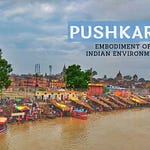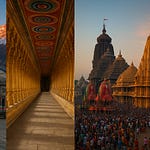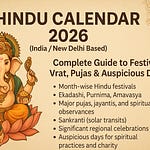Just three hours from Bengaluru lies a breathtaking symbol of faith, history, and resilience - a temple that vanished beneath the waters of a great dam and was later resurrected, stone by stone. The Venugopalaswamy Temple near the KRS backwaters in Mandya is not merely an architectural wonder; it is a living legend that bridges the past and the present.
A Legacy Beneath the Waters
In the 12th century, during the glorious reign of the Hoysala Empire, a majestic temple was built in the riverside village of Kannambadi - dedicated to Lord Krishna in his divine flute-playing form, Venugopala Swamy. This temple reflected the finest of Hoysala craftsmanship, known for its symmetrical design, ornate carvings, and artistic grace that celebrated devotion through stone.
Centuries later, in the early 1900s, the visionary engineer Sir M. Visvesvaraya designed the Krishna Raja Sagara (KRS) Dam, commissioned by Maharaja Krishna Raja Wadiyar IV of Mysore. The project was a modern engineering marvel that promised prosperity to the region - but it came at a cost. The rising waters of the dam submerged Kannambadi village, and with it, the ancient Venugopalaswamy Temple disappeared beneath the reservoir.
For over seven decades, the temple lay hidden under water, surfacing only during severe droughts - its fleeting appearances stirring wonder and reverence among locals who still remembered its glory.
The Great Resurrection: A Modern-Day Miracle
In the early 2000s, a remarkable act of devotion and preservation began. The Khoday Foundation, under the guidance of industrialist and philanthropist Sri Hari Khoday, undertook a monumental task - to relocate and rebuild the temple, stone by stone.
Over 16,000 individual stones were carefully photographed, numbered, dismantled, transported, and reassembled at a higher site near Hosa Kannambadi, just a kilometre from the original submerged location. The work required years of meticulous planning and the expertise of skilled artisans who restored every carving to its rightful place.
The reconstruction preserved the exact Hoysala proportions, retaining the sanctum (garbhagriha), the navaranga (pillared hall), mantapa, vimana, and sub-shrines - all aligned according to traditional temple geometry (vastu shastra).
By 2011, the temple was completely restored and reconsecrated (kumbhabhishekam), once again welcoming devotees to worship beneath its ancient spires.
Architecture and Artistic Grandeur
The Venugopalaswamy Temple is a quintessential example of Hoysala architecture, with its intricate soapstone carvings and precise symmetry.
The temple complex is built on a platform (jagati), a hallmark of Hoysala design that allows circumambulation (pradakshina).
The main sanctum enshrines Lord Venugopala (Krishna), gracefully holding his flute (venu).
Surrounding the sanctum are 46 sub-shrines, each dedicated to various deities associated with Krishna, Vishnu, and Vaishnava traditions.
Every pillar inside the mandapa is a masterpiece, carved with floral patterns, mythological figures, and dancers frozen in stone.
The ceiling panels feature lotus motifs, while the outer walls depict scenes from the Bhagavata Purana and Mahabharata.
The vimana (tower) rises with understated elegance, maintaining the pyramidal symmetry typical of Hoysala temples like those in Belur and Halebidu.
When the sun sets behind the KRS backwaters, the temple’s silhouette, reflected in the still water, creates a sight of unmatched beauty - a serene union of nature and devotion.
Spiritual and Religious Significance
Venugopala Swamy, the central deity, represents Lord Krishna as the divine flute player, symbolizing love, peace, and cosmic harmony. The temple is a revered site for Vaishnavites and Krishna devotees who visit from across South India.
Daily Pujas and Rituals
Morning Puja: Begins with Suprabhata Seva and Abhisheka (ritual bathing of the deity).
Madhyana Puja: Includes Naivedya (food offerings) and Mangala Aarti.
Evening Puja: The temple glows with lamps for the Sandhya Deepa Aarti, a deeply spiritual moment when the deity’s reflection shimmers on the water.
Festivals
Janmashtami (Krishna’s Birth Festival) is celebrated with grandeur, with bhajans, recitations, and a special midnight aarti.
Vaikuntha Ekadashi and Makara Sankranti are other major observances.
Annual Rathotsava (chariot festival) draws pilgrims from Mandya, Mysuru, and beyond.
Aarti and Darshan Timings
Morning: 6:00 AM – 12:30 PM
Evening: 4:00 PM – 8:00 PM
(Timings may vary seasonally; visitors are advised to check locally.)
Dos and Don’ts for Visitors
What to Do
Dress modestly and respectfully.
Remove footwear before entering the sanctum area.
Offer flowers, fruits, or coconut as permitted.
Maintain silence and reverence during pujas and aarti.
Respect photography restrictions inside the inner sanctum.
Carry drinking water and sun protection, as the site can get hot in the afternoons.
What Not to Do
Avoid littering - help preserve the sanctity and cleanliness of the site.
Do not climb on or touch the sculptures.
Avoid loud music or mobile use within temple premises.
Alcohol, smoking, and non-vegetarian food are strictly prohibited nearby.
How to Reach
By Road:
Distance from Bengaluru: approximately 140 km (around 3 hours via Bengaluru–Mysuru Expressway).
Route: Bengaluru - Mandya - Srirangapatna - KRS - Hosa Kannambadi.
The final stretch from KRS to the temple passes through scenic countryside and the backwaters.
By Rail:
Nearest major station: Mysuru Junction (about 25 km).
From there, local taxis or autos can take you to the temple.
By Air:
Nearest airport: Mysuru Airport (35 km) or Kempegowda International Airport, Bengaluru (around 180 km).
Nearby Attractions
Krishna Raja Sagara (KRS) Dam - A marvel of early 20th-century engineering.
Brindavan Gardens - Famous for its musical fountains and evening light show.
Ranganathittu Bird Sanctuary - Ideal for nature lovers and photographers.
Srirangapatna - Historical town with Ranganathaswamy Temple and Tipu Sultan’s legacy.
Mysuru Palace - Just 30 km away, a must-visit heritage gem.
Experience Beyond Worship
Visitors often describe the Venugopalaswamy Temple not just as a religious destination but as a spiritual experience - a place where time seems to pause. The interplay of stone, sky, and water gives it an ethereal quality, especially during sunrise and sunset.
For photographers, heritage enthusiasts, and seekers of peace, it’s an unforgettable site that blends myth, memory, and architecture in perfect harmony.
Best Time to Visit
Post-Monsoon (October–February): Pleasant weather and full backwaters.
Summer (March–May): Dry conditions but easier access to the site.
Avoid peak monsoon when access roads can be slippery.
Ideal visiting hours: 6 AM – 10 AM and 4 PM – 7 PM for the best lighting and peaceful darshan.
In the Words of Devotees
“It’s like watching history breathe again - a temple that once slept beneath water now stands tall, reflecting both faith and human perseverance.”
“When the lamps are lit during aarti and their glow dances on the backwaters, it feels like heaven on earth.”
A Temple That Teaches Resilience
The Venugopalaswamy Temple at KRS is more than a restored monument - it’s a metaphor for rebirth. From submergence to resurrection, from forgotten to celebrated, it stands as a tribute to Karnataka’s devotion, artistry, and commitment to heritage.
In its carvings and corridors lives a story of faith that defied the waters of time - a story every traveler and devotee should witness at least once.










